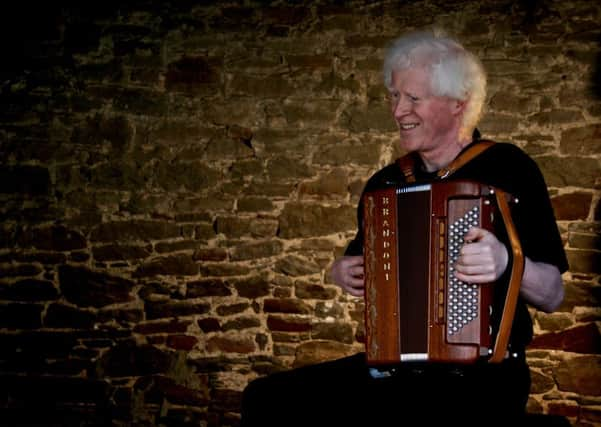The book that charts a musical map of Scotland


Imagine, if you will, a sound map of Scotland; one that not only shows the lie of the land in all its multifariousness, but conveys its music and, perhaps most essentially, the life-affirming pulse of dancing feet. Fanciful, perhaps, but the image is brought to mind by a magnificent collection of tunes, photographs and reminiscences by the accordionist, dance band leader and prolific tune composer, Freeland Barbour. Published by Birlinn, the sumptuously illustrated two volumes of The Music and the Land is launched tonight with a concert and ceilidh at Edinburgh’s Queen’s Hall, featuring Barbour’s band the Occasionals, as well as numerous guests.
Containing over 400 tunes, as well as explanations of the people, places and as often as not, landscapes which inspired them, The Music and the Land features glowing photography by the Skye-based photographer Cailean MacLean, with additional images by Robin Gillanders, Shona MacMillan and others.
Advertisement
Hide AdBarbour’s distinctively white-haired, accordion-wielding figure has been a kenspeckle figure on the Scottish dance scene over four decades or more, leading the Wallochmor Ceilidh Band, the Ghillies and the Occasionals in crisp style. Also a producer, initially with the BBC and then running one of the largest independent recording studios in the country, he retains a seemingly boundless energy and appetite for taking his dance music on the road, enlivening many village halls, from the Border country to the voes of Shetland.
The book, he explains, has been in gestation for more than 30 years but can be traced back to a fine evening in his native Highland Perthshire. “About 35 years ago,” he explains, “I was sitting on a dyke above Glen Fincastle where I come from, on a beautiful September evening, looking north to the hills above Blair Athol, and I was thinking what a fantastic scene it was and I wrote a little air there and then, The Hills of Atholl. Then I thought, ‘Wouldn’t it be nice to have a representation of the place to go with the music?’”
The idea remained at the back of his mind until he became accordion tutor at the newly launched Scottish music BA degree course at the RSAMD, which, among other things, made funds available for staff development and the concept of the book was dusted down. Around then, however, he bought Castlesound studios in Pencaitland from producer Calum Malcolm, which occupied much of his time. In recent years, however, he has stepped back from the day-to-day running of the studio, enabling him to get on with the book. “It’s much bigger than I ever intended,” he says, “because during all those years that went by I was still writing music.”
He’s delighted, however, with the resulting two handsome volumes (due to be joined by a smaller paperback collection of bagpiper arrangements of some 60 of his tunes). As well as the photographers, he pays tribute to pianist Jane Gardner, who put all his music into Sibelius software for the book (and will play piano at tonight’s fling).
Barbour has divided the collection geographically into regions of Scotland, and as his musical roving hasn’t been confined by any means to Scotland, there are chapters dealing with England, Ireland, Scandinavia and North America. Format established, he then invited one of his many friends in music to write an introduction for each chapter. Singer-songwriter and fellow-radio producer Rab Noakes, for instance, introduces the Fife chapter by recalling growing up there and delivering papers to Eck Harley, who he didn’t realise at the time was a notable source singer.
Writing on Barbour’s native Perthshire, Dougie Maclean recalls how they both served, at different times, in the ranks of the seminal folk band Silly Wizard, while the elder statesman of English folk, Martin Carthy, introduces a nautical section, dealing with the many sea shanties which Barbour has fashioned into first-rate dance tunes.
Advertisement
Hide AdWhen Barbour left the emerging Silly Wizard, his place on the accordion stool was taken by an extremely young Phil Cunningham, who has gone on to become a renowned musician and broadcaster in his own right and who introduces the book’s Edinburgh section by declaring, “I blame Freeland for everything ...”
The dance, meanwhile, goes on. Paying tribute to Barbour’s prowess as a dance musician, broadcaster Robbie Shepherd quotes Sir Jimmy Shand’s famous remark when asked for the secret of his immaculate timing: “I jist play tae the feet o’ the best dancers in the hall, son.”